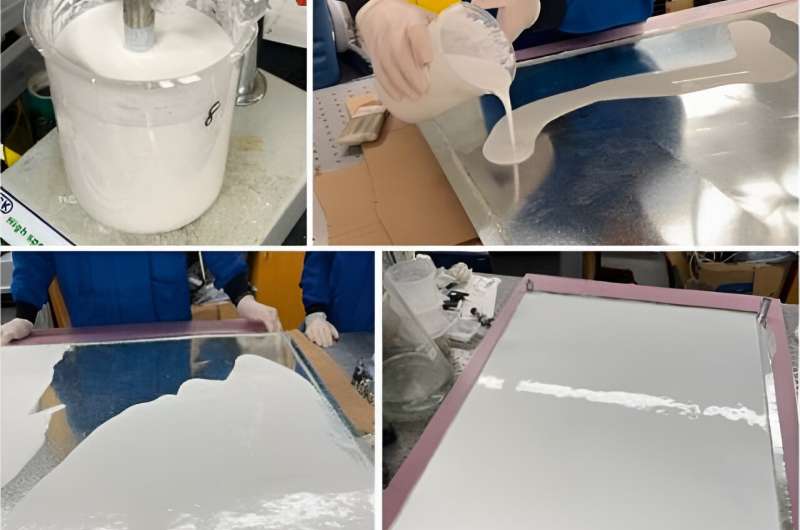This article has been reviewed according to Science X's editorial process and policies. Editors have highlighted the following attributes while ensuring the content's credibility:
fact-checked
trusted source
proofread
Is cooling paint the key to turning down the planet's temperature dial?

The summer of 2024 has been another scorcher, with the highest temperature ever recorded by NASA on July 22 and the city of Phoenix reaching a milestone of 100 straight days of 100 degrees.
To Northeastern professor Yi Zheng, the news is another indication of the world's need for a "cooling paint" technology being developed by his startup, Planck Energies.
Zheng says the passive technology could help dial down planetary temperatures, brush stroke by brush stroke, by cooling everything from buildings and rooftops to roadways and cycling paths.
"This has the potential to reduce air conditioning electricity and carbon emissions, which will have a significant global impact," says Zheng, an associate professor of mechanical and industrial engineering.
"My plan actually is to apply passive cooling materials to all exposed surfaces all over the world," he says. "Our ultimate goal is to address global warming and reduce the carbon footprint, greenhouse gas emissions."
Experimental success
Also known as cool roof technology, the cooling paint is light or white in color to reflect rather than absorb heat.
The paint's reflectivity is enhanced by smart optical components, Zheng says.
But the cool roof concept goes beyond shrugging off the impact of incident sunlight—also known as solar energy—he says.
It also uses nanotechnology to draw heat out of buildings and sends the infrared radiation to outer space via wavelengths not absorbed by the Earth's atmosphere, Zheng says.
"The Earth keeps receiving energy from the sun, but we never return energy back to the universe. That is a major issue. Passive cooling is one way we can effectively return the excessive heat," he says. "It's the cooling of the whole world, the cooling of the Earth."
Results from recent tests in Texas and on Northeastern's Burlington campus have proved promising, with an indoor temperature drop of at least 5°C in storage sheds coated with the cooling paint, Zheng says.
Solving the 'AC paradox'
He says successful implementation of the cooling paint could help alleviate or decrease the need for air conditioning.
In what is known as the AC paradox, growing temperatures and populations have driven up the demand for air conditioning, which in turn increases greenhouse emissions that contribute to continued global warming.
"Every degree of cooling this (paint) provides is a degree that doesn't have to be cooled by an air conditioner," Zheng says.
He says the goal is to develop commercial applications of the cool roof technology that is ready for use in 15 to 18 months.
Planck Energies is working with 3M on mixing the cool roof technology into paint that can be brushed or sprayed on the roofs of food warehouses, data centers and refrigerator trucks that need to be kept to a lower temperature, Zheng says.
"Our targeted customers are commercial partners like the paint industry," which can use the cooling technology as a paint additive, he says.
In the future, the technology could be applied to houses, apartment buildings, roads and bicycle and walking paths, including trails along the Charles River in Boston, he says.
Zheng also foresees nongovernmental organizations and possibly the United Nations helping to underwrite the application of the cooling technology in lower-income communities in Africa, the Middle East and China that are experiencing the worst effects of global warming.
Easy to use
"It's really easy to apply this material over an exterior surface," Zheng says. "You can either spray the paint or brush the paint and you can also control the thickness of the painting."
He saw firsthand this summer how easy the technology is to use when Planck Energies constructed and painted storage sheds on the Burlington campus and at the University of Texas in Dallas to see how well the cooling paint performed against simple white paint.
As he predicted, the cooling paint outperformed the white paint.
The Northeastern factor
Zheng, who in July was awarded the prestigious 2024 Raymond Viskanta Award for his work in the field of radiative heat transfer, says Northeastern support for his startup has been essential.
The university's Center for Research and Innovation not only provided seed money but helped file patents and execute licensing agreements that protect the startup's intellectual property, as well as providing free-of-charge entrepreneurship training and mentoring, he says.
Planck Energies is not alone in developing white cooling paint technology, Zheng says. "I know there are so many competitors and collaborators out there."
But in the effort to cool homes and workplaces through passive technology, Planck Energies' cooling paint has the benefit of being self-cleaning, fire resistant and environmentally friendly, Zheng says.
"It's important to make this climate technology available as soon as possible," he says. "Passive cooling technology can be one technology used to save the world."
This story is republished courtesy of Northeastern Global News news.northeastern.edu.


















